Mammal Pests
How to Tell What’s Digging and Eating in Your Garden
or Squirrels, Raccoons and Moles, Oh My!
By Diane Allen
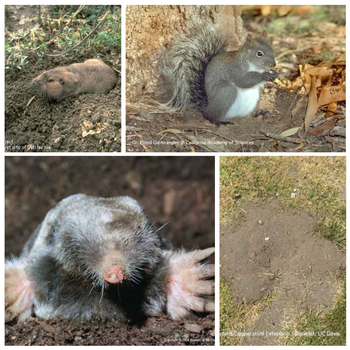
Fast forward several years, we wondered what happened to our lettuce plants, which were dying and lifted ever so easily from the raised bed, with shriveled roots! (Moles that time).
And which culprit was taking one bite of our ripe Santa Rosa plums and cherry tomatoes and unceremoniously tossing the otherwise good fruit! (Tree squirrels).
All this is to say that little (and larger) fellow mammals love to share our yard, our plants, and our homegrown produce. After all, they enjoy our garden as much as we do – and an animal has to eat! So, what to do??
This article will briefly describe the ways to identify some of the creatures that may be causing havoc in your garden, and some ways to control the damage! We will focus here on tree squirrels, ground squirrels, gophers and moles, but will also include references for you at the end raccoons, deer, rats, voles, opossum and skunks (all commonly seen in east bay yards).
Wild Creatures in Our Yards
At first, one might think that we should try to trap or otherwise eliminate these mammal pests from our yards. Don’t they carry disease? Won’t they destroy our entire yard? Well, yes, in some cases. But if you think about it, even in an urban neighborhood we share the environment with wildlife all the time, from birds and butterflies to raccoons and opossums. And if you happen to live in or near a more rural area, you may see foxes, deer, or even bobcats and the occasional mountain lion! They are a source of wonder and beauty, but also can be a source of damage to the home and yard.
Usually, by taking the proper mitigation measures we can limit such damage and find a happy medium where we can share our gardens with some of our wild four-legged neighbors such as tree squirrels, opossum and deer. For example, using bird feeders that prevent bird seed from falling on the ground can prevent the seed from being a potential food source for animals such as squirrels and rats. Other mammal pests, however, may require stronger measures such as trapping to limit their numbers and more serious damage to our plants and trees, as discussed in those cases below.
Wild Creatures in Our Homes
Yes, several of these creatures can invade our basements and attics as well as our yards, including raccoons, squirrels and rats. Mitigation measures such as thinning vegetation next to the house and sealing all cracks and holes in foundations, siding and attic vents can help prevent these invasions. The references below will give more details on these preventative steps that pertain to each animal.
Squirrels
There are two main types of squirrels in California: ground squirrels and tree squirrels. Ground squirrels are troublesome rodent pests for many home gardeners, and are found throughout the state, generally near open grassy areas. Tree squirrels are found not only in rural or open areas but even in large cities.
Ground squirrels look similar to tree squirrels and can climb trees, but you can tell which type you have with these differences. Ground squirrels have gray and white markings and slightly bushy tails; when startled or frightened, they almost always retreat to a burrow hole in the ground. Tree squirrels on the other hand are easily distinguished by their long bushy tails, their lack of spots or stripped markings, and the fact that they escape by climbing trees and other structures and never use a burrow.
Tree Squirrels
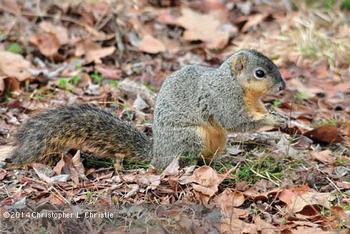
Four Tree Squirrel Species
There are four species of tree squirrels in California. It’s important to know which species you have in your yard as tree squirrels are classified as game mammals by the California Fish and Game Code and can be controlled only as provided by the state hunting regulations, as discussed below. Different rules apply to different tree squirrel species.
Eastern fox squirrels
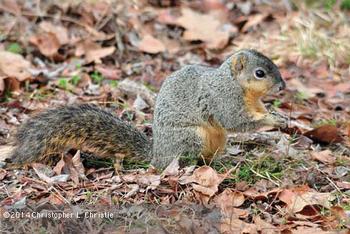
Eastern gray squirrels (Sciurus carolinensis)
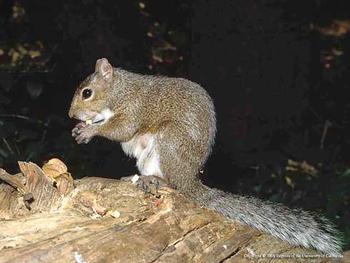
Western gray squirrels
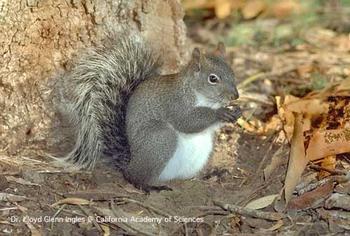
Douglas squirrels
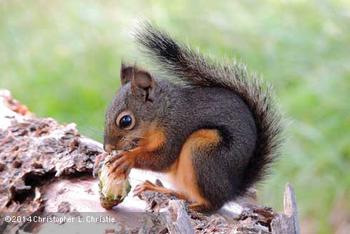
Managing Your Tree Squirrels
General Methods
It may be possible to have a peaceful coexistence with a tree squirrel in your yard if you have an abundance of fruit and vegetables to share. But if you see squirrels in your trees, some kind of preventive action should be taken. Squirrels can strip a tree of its crop in a short time, and they also may strip the bark to feed on the juicy inner bark layer (cambium), causing injury to the tree. Sometimes if there are other unprotected fruit or nut trees available to the squirrels, you can protect the crop of a single tree by netting it as you would to exclude foraging birds. While squirrels can readily gnaw through the plastic netting, they may not persist if enough alternative food is easily available.
Keeping Them Out of Your Home and Yard
To keep squirrels out of your home, screen or block all potential entrance sites such as small gaps under the eaves, overlapping roof sections, and knotholes, which can prevent tree squirrel access to buildings. Because they often travel on overhead telephone lines, power lines, and fence tops, they frequently find entrances at about these heights.
While it is relatively straightforward to keep squirrels out of buildings (not easy, but straightforward), keeping them out of a yard or garden is a continuous challenge. Trees that overhang roofs or are close to telephone lines should be cut back to slow the movement of squirrels about the yard. And squirrels can be discouraged from digging up newly seeded or established crops by covering the rows with cage-like freestanding covers made of one–inch hexagon chicken wire. Although some chemical repellents are registered for use to keep tree squirrels out of an area, their effectiveness is questionable. There are also repellents that are added to birdseed that are supposed to prevent squirrels from feeding on the seeds in bird feeders. However, these, too, have not shown to be effective.
Tree squirrels quickly become habituated to frightening devices using visual or sound cues, and pay little attention to them after a couple of days. A number of these devices are on the market, but none have proven very effective. You really can’t just scare them away.
Tree squirrels, though, are quick to escape when pursued by predators. Some dogs that have full run of the yard may keep squirrels at bay, or at least from running down to eat your tomatoes!
Trapping
If you have a serious problem with squirrels, trapping is another alternative (either setting traps yourself or hiring a professional company to do that).
Remember though that releasing any tree squirrel elsewhere is illegal (there is only one exception, for the release of gray squirrels, under a permit issued by the California Department of Fish and Wildlife ).
So traps generally must be lethal; squirrels caught in live traps must be euthanized, as discussed below.
Tree squirrels are classified as game mammals by the California Fish and Game Code and can be controlled only as provided by the hunting regulations. However, two exceptions exist for the lethal removal of tree squirrels:
- Gray squirrels - Any owner or tenant of a property that is in danger of being damaged by gray squirrels may apply to the California Department of Fish and Wildlife (CDFW) for a permit to control such squirrels. The Department, upon receipt of sufficient evidence, may issue a revocable permit for the removal and disposition of these squirrels. When a permit to trap the gray squirrel is issued, the Department may designate the type of trap to be used, and may also require that squirrels be released in parks or other nonagricultural areas.
- Eastern fox squirrels injuring crops or property may be controlled at any time and in any legal manner by an owner or tenant without a permit.
It is not legal, though, to use poison baits to kill any tree squirrel species. Baits can be ingested by unintended targets like pets, owls and other predators such as hawks.
Live-catch traps
Live-catch cage traps are also available, but once caught the squirrel must be euthanized, presenting a problem for some. Remember, releasing any tree squirrel elsewhere is illegal unless a proper permit is issued by the California Department of Fish and Wildlife beforehand, and the issuance of such a permit is unlikely in most situations.
For more information on trapping, and other additional tree squirrel details, see: http://ipm.ucanr.edu/PMG/PESTNOTES/pn74122.html
Ground Squirrels
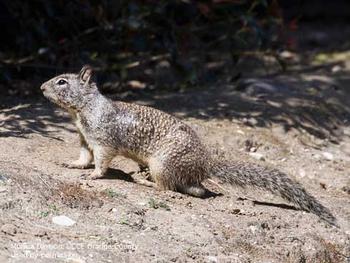
Unlike gophers and some other burrowing animals, the burrow openings of ground squirrels are quite open, without mounds of dirt around them. They may be either in an open area of your yard or at the edge of building foundations.

Their burrowing can be quite destructive. Burrows and mounds make it difficult to mow lawns and other grassy areas, and they present hazards to machinery and pedestrians. Burrows around trees and shrubs can damage roots, sometimes toppling trees. Burrowing beneath buildings and other structures sometimes produces damage that necessitates costly repair.
Managing Your Ground Squirrels
You'll generally find ground squirrels in open areas, although they sometimes use brush and other vegetation to hide during retreat. Removing brush piles and debris make an area less desirable to them in this way. Brush removal also aids in detecting squirrels and their burrows and improving access during management.
California ground squirrels generally dislike dense vegetation, as it prevents easy detection of their potential predators. Therefore, avoiding mowing can discourage ground squirrels; keep in mind, though, that increasing the amount of vegetation in an area may encourage other pest species, like California field mice.
Ground squirrels can reinvade a site by moving into vacant burrows. Although not usually possible in urban areas, destroying old burrows by deep ripping them to a depth of at least 20 inches, using a tractor and ripping bars, can slow reinvasion. Simply filling in the burrows with soil does not prevent reinvasion, as ground squirrels easily find and reopen old burrows!
There are no effective squirrel-frightening devices or repellents that will cause ground squirrels to leave their burrows or avoid an area or crop.
Baits and trapping
Baiting and trapping can be effective if used during the appropriate time of year. Unlike tree squirrels, the California Fish and Game Code classifies ground squirrels as nongame mammals. An owner or tenant can control (“take”) nongame mammals that are injuring crops or other property in any legal manner.
It’s important to know the proper use and safety issues for baits, lethal traps and similar methods. Lethal traps are usually recommended; if using live capture traps the captured animal must be euthanized. Remember, it is illegal to relocate wildlife in the State of California without a permit. Follow this link if you are having a ground squirrel infestation and need information on control measures.
Gophers (aka Pocket Gophers)

Gophers often invade yards and gardens, feeding on many garden crops, ornamental plants, vines, shrubs, and trees. They use their sense of smell to locate the food, and then typically feed on the roots and fleshy portions of the plants they find while digging.
A single gopher moving down a garden row can inflict considerable damage in a very short time by pulling entire plants into their tunnel from below! Gophers also gnaw and damage flexible plastic water lines and irrigation systems, particularly those types used for drip irrigation. Their mounds can destroy garden beds.
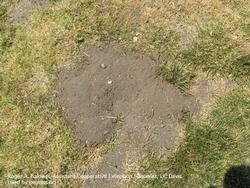
Managing Your Gophers
Exclusion
Keeping gophers away from your plant roots is one preventative measure you can take. To protect individual valuable shrubs or trees, the effort of underground “fencing” might be worthwhile. For existing plantings, bury hardware cloth or ½- to ¾-inch mesh wire at least 2 feet deep with an additional 6 inches of mesh or wire bent at a 90-degree angle away from the planting. This will help keep gophers from digging around the fencing boundary. Also, extend the fencing at least 1 foot above ground to deter gophers from moving overland. Use galvanized or stainless steel wire to extend the life of the fencing. This method is not perfect, though, because persistent gophers can burrow below the wire and the wire can restrict and damage root growth of trees.
You can protect small areas such as flower beds by complete underground screening of the bed's sides and bottoms. When constructing raised vegetable or flower beds, underlay the soil with mesh wire to exclude gophers. To protect new individual plants, install wire baskets at the same time you are putting the plants into the ground. You can make these at home or buy them commercially.
Use light-gauge, ¾-inch, non-galvanized steel wire for shrubs and trees that will only need protection while young; the wire will rust and disintegrate after several years, preventing growing roots from becoming strangled. Choose baskets large enough to allow for the roots to grow for several years.
To help protect underground flexible sprinkler lines or utility cables, deter gophers by placing 6 to 8 inches of coarse gravel (1 inch or more in diameter) around the lines.
Changing their habitat
Reducing gopher food sources can decrease the attractiveness of gardens to gophers. If feasible, remove weedy areas adjacent to yards and gardens to create a buffer strip of unsuitable habitat.
No repellents have proven effective at protecting gardens or other plantings from pocket gophers. Plants such as gopher purge, Euphorbia lathyrus, castor bean, Ricinus communis, and garlic have been suggested as repellents, but research has not substantiated these claims.
Although many devices designed to frighten pocket gophers are commercially available—including vibrating stakes, ultrasonic devices, and wind-powered pinwheels—these rodents don't frighten easily, probably because of their repeated exposure to noise and vibrations from sprinklers, lawnmowers, vehicles, and people moving about. So trying to scare them away sadly isn’t effective.
Predators
While predators (such as owls, snakes, cats, dogs, and coyotes) eat pocket gophers, predators rarely remove every gopher. When a single gopher, which is capable of causing damage rapidly, invades a yard or garden, a gardener can't afford to wait for an owl to arrive. It is better to immediately take effective action through the measures above or trapping or perhaps baiting.
Trapping and Baiting
Of the two methods, lethal trapping is the safer (and effective) way to control gophers. You can do this yourself, or hire a professional to trap and remove the gophers.
It is important to remember that bait application for gophers is only allowed directly within burrow systems; above-ground application is illegal and ineffective and may expose pets and unintended wildlife to poison bait.
Moles
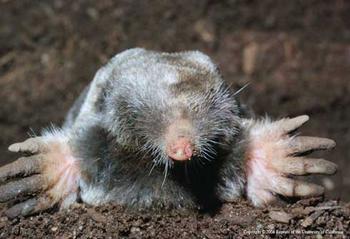 Adult mole, Scapanus sp. Photo by Jerry P. Clark.
Adult mole, Scapanus sp. Photo by Jerry P. Clark.

Now that we’ve addressed ground squirrel and gopher issues, don’t think we’re in the clear! We now move on to a smaller burrowing friend you may experience in your yard – the mole. Moles are small insect-eating mammals. Contrary to a commonly held belief, the mole isn't part of the rodent family. In California, moles inhabit the Sierra Nevada, coastal range mountains and foothills, and (important to us), the entire coastal zone. And do we have moles in Alameda County!
Moles live almost entirely underground in a vast network of interconnecting tunnels. They frequently create shallow tunnels just below the surface where they capture worms, insects, and other invertebrates. While they may sometimes consume roots, bulbs, and other plant material, they are really looking for insects to eat. (Usually plant root chewing is caused by gophers or other rodents). The greatest damage from moles occurs just through their burrowing activity, which dislodges plants and can kill them by drying out their roots. The resulting mounds and ridges are also unsightly and can disfigure your garden.
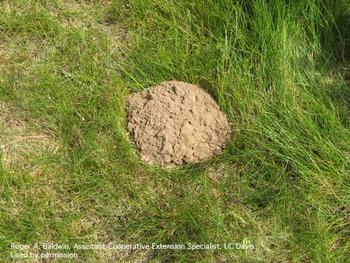
Surface feeding burrows appear as ridges in the topsoil, created when the mole pushes up by forcing its way through the soil. Some of the surface runways are temporary. More permanent tunnels are deeper underground and are usually about 2 inches in diameter and 8 to 12 inches below the surface.
Moles are active throughout the year, although surface activity slows or is absent during periods of extreme cold, heat, or drought (although drought hasn’t seemed to slow down the mole in my yard!) The greatest mole activity occurs usually after rainfall or watering events when digging new tunnels is easiest.
Managing Your Moles
Because mole damage is unsightly and can destroy valuable plants, the number of moles that can be tolerated in your yard is usually quite low, sometimes even zero! As soon as you see an active mound or surface runway, it’s best to start control actions as soon as you can. Once you have controlled the damage, also monitor your yard for re-infestation.
Several methods of control are available, but no single method has proven fail-proof. It may be necessary to use a combination of techniques.
Exclusion Methods
You can try to keep moles away from your plantings by installing a vertical underground barrier to provide temporary relief. To protect existing plantings, bury hardware cloth or 1/4-inch wire mesh in a 6-inch wide trench at least 2 feet deep with an additional 6-inch lip of mesh bent at a 90-degree angle away from the planting. This lip will help deter moles from digging under this “fencing”. Another 6 inches of fencing should protrude above ground to eliminate above-ground mole traffic into the exclusion area. Burying wire can be difficult and time-consuming, so galvanized or stainless steel wire is recommended to prolong the life of the fence.
Exclusionary fencing is not perfect, however, as persistent moles can eventually find a way to burrow around the fencing. Eventually, removal techniques may be required to eliminate moles that find their way into exclusion areas. Alternatively, wire-mesh baskets will prevent moles from heaving planted bulbs out of the ground. Perhaps one of the most successful methods is to install wire mesh bottoms in raised beds, which will totally exclude moles in those beds.
Trapping
Lethal trapping is the most universally applicable and dependable method of mole control. Several different kinds of mole traps are available at hardware stores, nurseries, or directly from the manufacturer, or you can hire a professional to set traps and remove the animals. Keep in mind that the best mole traps differ from those for pocket gophers; very few traps are effective for both animals.
Follow this link for additional information on trapping moles and other control methods.
Other Mammal Friends and Foes/References
There are several other animals that you may encounter in your yard that may cause damage to your garden or home. Below are links to give you information on how to identify signs of their damage, and control measures you can use to limit that damage.
- Raccoons
- Skunks
- Rats (yes, they live in yards)
- Voles/Meadow Mice (yes, we have these in Alameda County):
- Opossum
- Deer
Want additional help?
Email the Alameda County Master Gardeners at acmg@ucanr.edu. Or contact us through our website.

